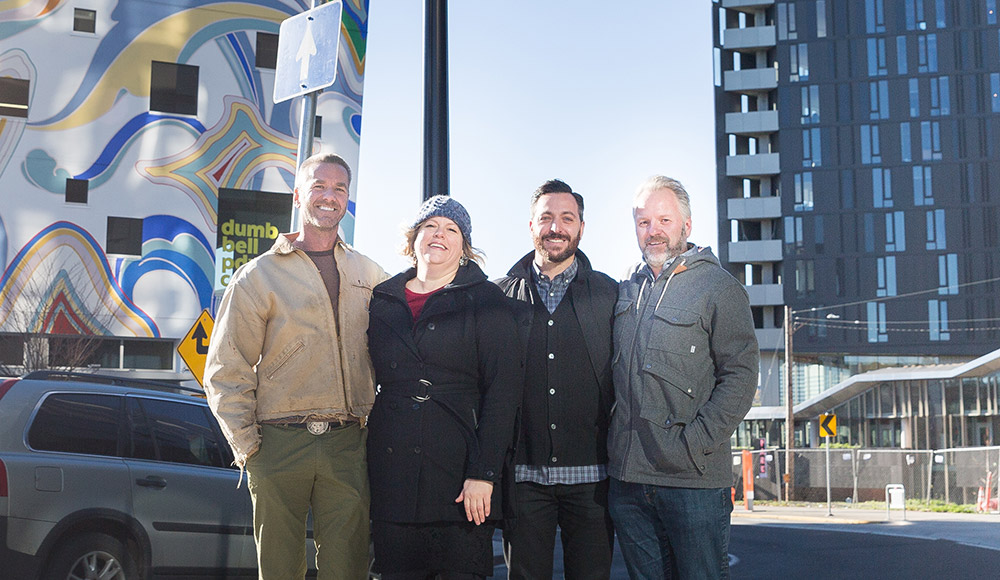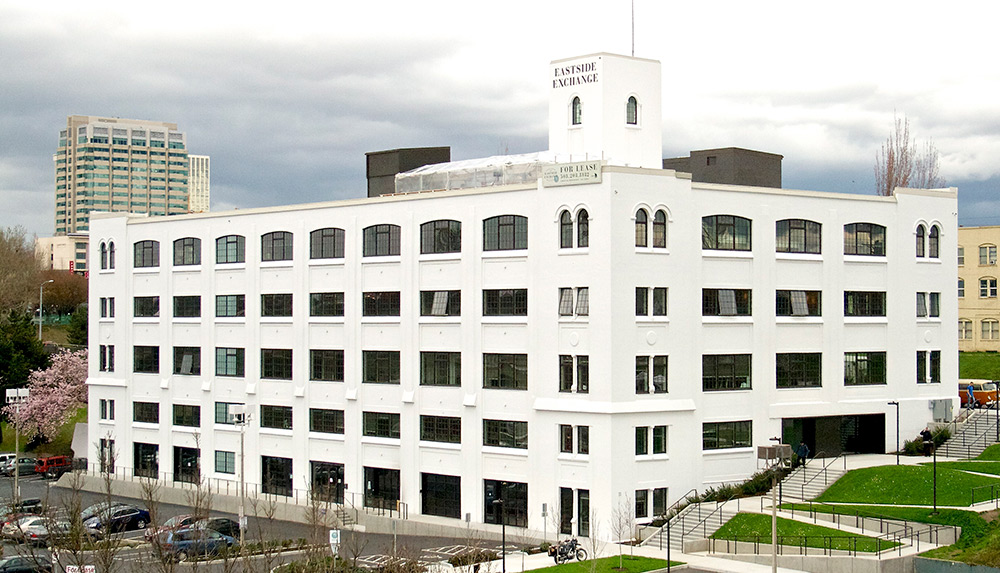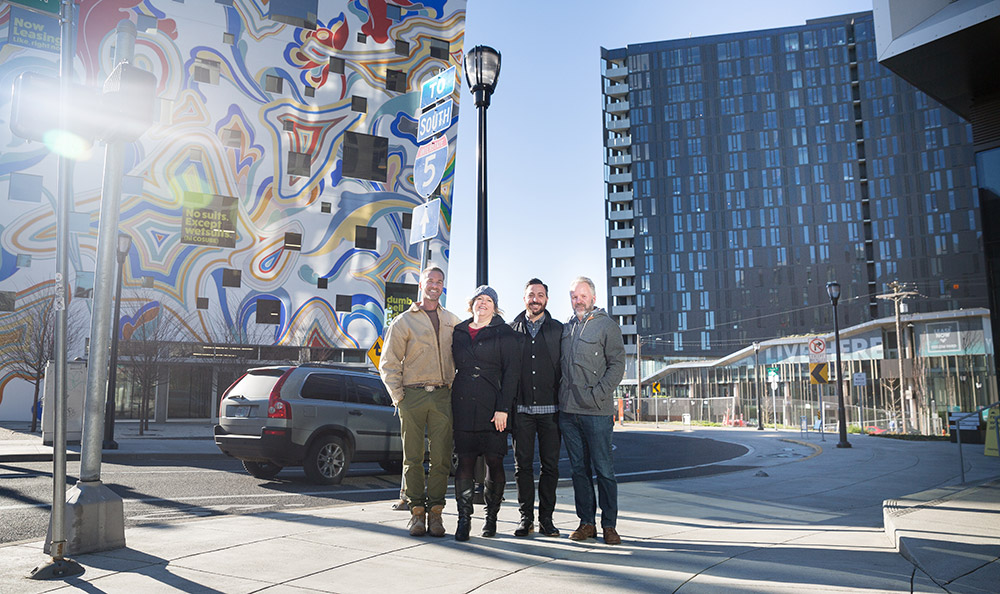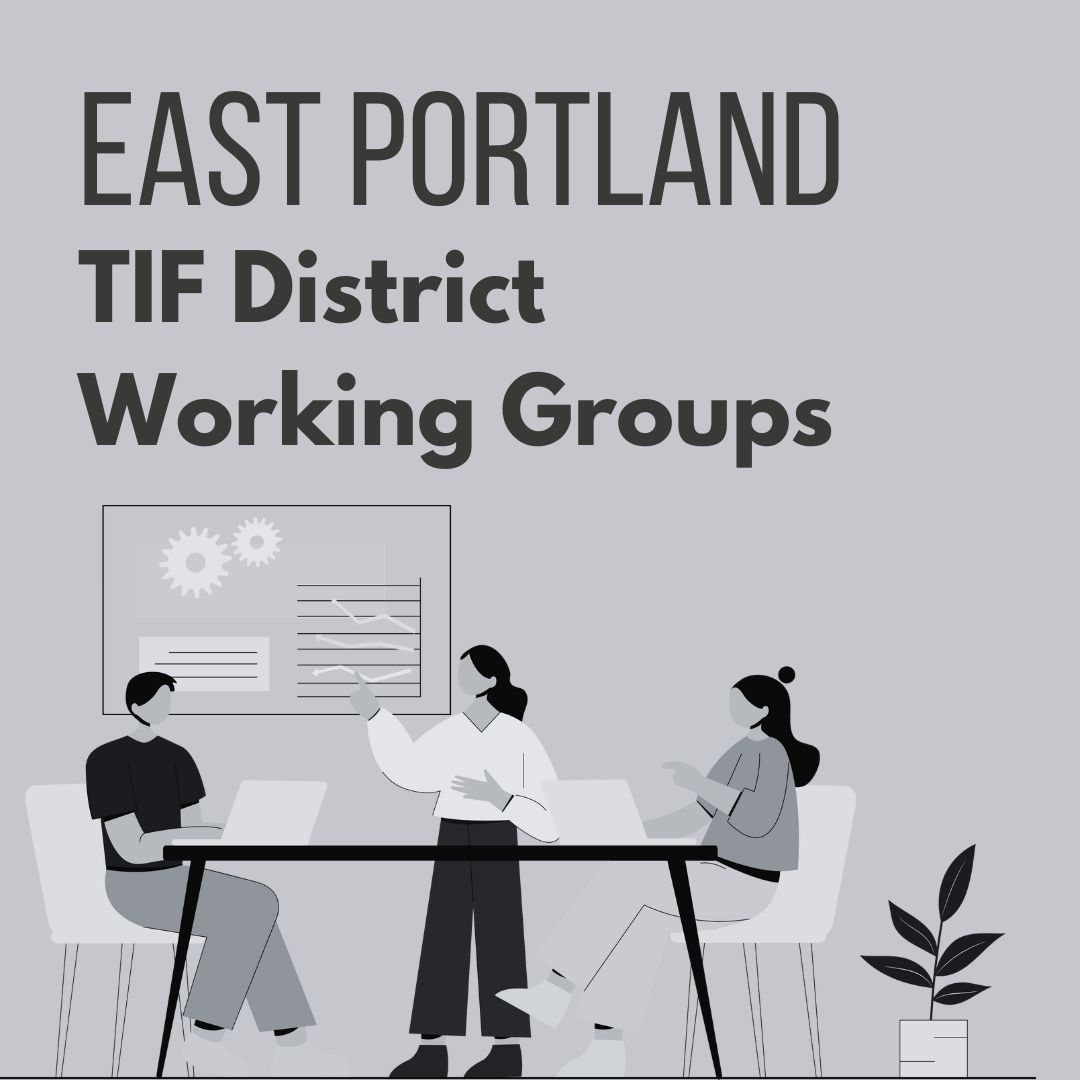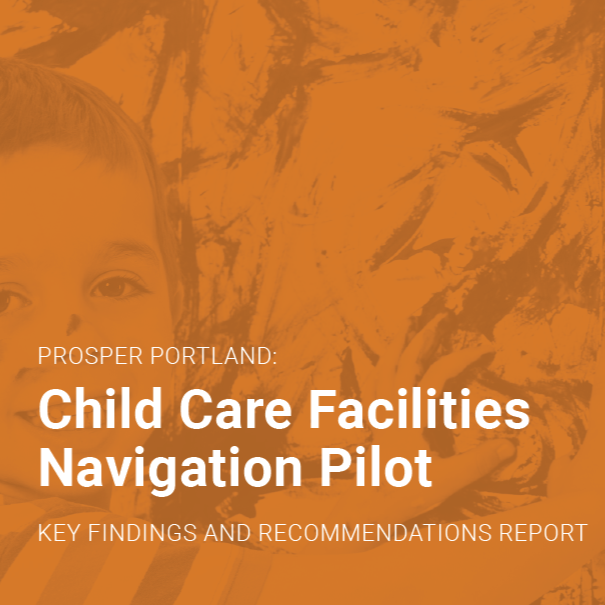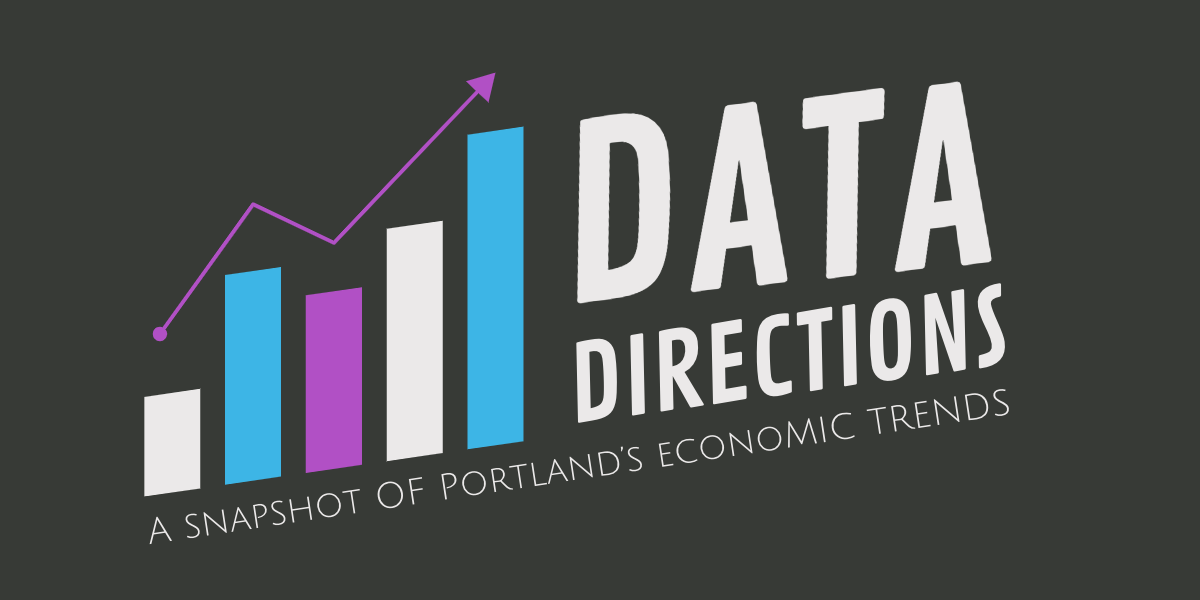Kevin Cavanaugh (KC), Guerrilla Development – developer of The Fair-Haired Dumbbell.
Geraldene Moyle (GM), Prosper Portland – project manager.
Jonathan Malsin (JM), Beam Development – developer of the Eastside Exchange.
Jeff Pickhardt (JP), Key Development – developer of The Yard.
What did you learn through the process of developing the Bridgehead? What could have been done differently?
KC: There were times early on where I felt like we butted heads; policy objectives changed midstream and caused some Issues. But later in the process we were partners on the same side, and that was a wonderful change. The Fair Haired Dumbbell was my first successful [Prosper Portland] project and it’s been a fun experiment in design and programming. In terms of doing something differently, while I wouldn’t change it, if I hadn’t crowdfunded the project I would have been further along in filling it right now. But I’m still really glad I did that; it was my own way of bringing everyday citizens to the investor table.
JM: One of the challenges was to think differently about the site and not have it be a monolithic, single developer-owned project. The planning we started in 2010 was based on the economic reality that a more incremental project for the site made sense as did retaining the Convention Plaza building (now Beam Development’s Eastside Exchange). We had experience with adaptive reuse and were keen on making sure that Prosper Portland’s board, leadership, staff and the neighborhood bought into saving that building. It’s definitely an extra lift to make sure you’re folding in MWESB providers into larger projects that still work with the economic realities of an inflationary construction market. It’s not easy, but I’m optimistic that the minority contracting community is growing.
JP: Ideally, we would have liked to have the timing of completion of all commercial spaces coincide with that of the residences. But our largest obstacle, and, as it turned out, the greatest benefit to the project, was getting a diverse project team on the same page. YARD was an effort between creatives and people minding the bottom line. The architectural response to a very sloped, very urban site was not obvious at first. The result was a successful conversion of a blighted space into a place where people want to gather and live. Another obstacle was the proposed project scale, which was in place throughout the project and even afterwards. This was difficult for people outside our team to reconcile. As time has gone on, people have become receptive, and now a neighboring project similar in scale is moving into the construction phase across Burnside.
GM: With the establishment of the Burnside Bridgehead Framework Plan in 2010, the approach to divide the property into multiple opportunities allowed for the redevelopment to acknowledge the history of the area and address community needs while evolving with the changes in the Central Eastside. Prosper Portland’s partnerships with three very different developers produced a lively mixed-use neighborhood in the Central City grounded in partnership and community priorities. In 2016-17 all four blocks were activated or under construction, fulfilling the framework plan for the area that called for a mix of uses to activate the site, build on its unique character, and provide opportunities for the community to gather.
When we started working on the Bridgehead, the agency had yet to shift its strategic focus more emphatically toward equity and creating more opportunities for underserved populations. So this is also a story of course correction over the eight-year development period: minority contracting numbers were low on these projects, highlighting the need to build these requirements into subsequent projects and ensure that development agreements reflect the commitment to equity that’s now central to our work.
What’s an unexpected benefit or pleasure from the project?
KC: It’s the most selfie-worthy intersection of the city. I love seeing strangers stop there to take a photo – it’s a designers’ Disneyland of an intersection.
JM: The Bridgehead actually came together the way we hoped with the framework plan. We saved this old building. We got to know the other developers in a very collaborative process. It’s great that we ended up with such different architectural styles. In the true built environment they play off each other well; in the long term they’ll be an important node of activity and architectural intrigue in the city. The unexpected pleasure of having so many architectural styles and developers is that the imperfections make the site authentic and true to Portland. People took chances with the architecture; there are no cookie cutter businesses – that’s the spirit of the Bridgehead. Shared values on the project are what we achieved in the process.
JP: In general, public discourse around architecture. Our team probably sought to make an iconic building. Now, we see that YARD is a unique building surrounded by other unique buildings in a neighborhood of historic buildings. It does not define the image of Portland or the Central Eastside; instead, and maybe luckily, it is part of an ensemble of quality material and design. This collective neighborhood quality is partly due to design guidelines and the process by which they are enforced and partly due to the people – developers, designers, builders – who care.
GM: Prosper Portland’s intent was to catalyze development in the northern Central Eastside. We’ve seen that intent come to fruition with the completion of projects on all of the property as well as adjacent parcels and the surrounding area – confirmation that the approach worked. The unexpected collaboration and partnership between the developers and Prosper Portland exemplifies the intent of our mission for our projects. Finally, leveraging the private development for public benefit is always a pleasure –we were able to incorporate public infrastructure like the Couch Street pedestrian access, which Prosper Portland did not have the funding to accomplish on our own, into the private development projects.
What role does equity play in the success of these projects and how you view your work as a developer?
KC: Right now that’s all I want to do – use my powers for good. My profession isn’t known for that. But it’s important to think about what’s inside the building, what’s the rent structure, how to give merchants time to become part of the neighborhood. Let’s leave some profit inside and curate a deeper experiment. Using crowdfunding meant inviting people into this arm of the economy; for me equity means giving people a voice.
JM: While acknowledging the gaps or difficulties with minority contracting, equity can also play a role in the landlord-tenant relationship. We’ve found a positive business model in taking a chance on people of all backgrounds. It’s been critical to many startups we’ve worked with to have that security; and critical to the character of the building to have a mix of tenants, not just large established companies. They have a certain creative, dynamic entrepreneurial spirit that is inspiring to be around. We’ve taken that chance at the Bridgehead both with the retailers we’ve worked with and the office tenants; we’re rented to many companies with softer credit than most developers would look for. And helping tenants get into good buildings with good landlords is a critical way to build an equitable economy.
JP: Starting from the beginning, with the Bridgehead Framework planning phase, and through completion of construction details, there is always an opportunity to hear another voice. The Bridgehead success should be measured at a broad scale, as the neighborhood “completes,” and at smaller scales: competitive and wide-reaching RFP issuance, including qualified underdogs in design, construction, and consultants. YARD was not just a building project. It was, and continues to be, a project for innovators and workers from all walks of life. You can start to measure this success with an observation of how YARD, as a building, invites people in to create a new, vibrant neighborhood.
GM: All of the Bridgehead projects came on line prior to Prosper Portland’s strategic shift to focus on prosperity and equity. But the lessons learned from contracting goals and implementation on these projects informed Prosper Portland’s requirements and educated our staff on ways to better incorporate equity into future projects and programs in the Central Eastside. Two examples are the Prosperity Improvement Program, which focuses on social equity goals to award investments, and the recently released ODOT Blocks Request for Proposal, which identifies and provides information on our expectations and requirements around Business and Workforce Equity and Community Benefit Agreements.
